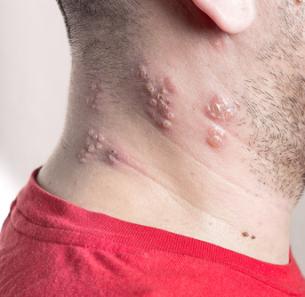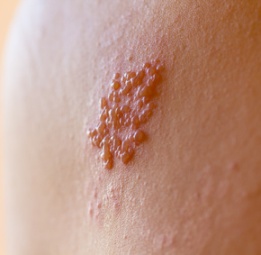
If you’ve had chickenpox, then you’ve likely heard about your risk of developing shingles. Unlike chickenpox, which generally attacks once in a lifetime, there is potential to develop shingles more than once, which is referred to as recurring shingles. Shingles is the inflammation of nerves beneath the skin caused by the same virus as chickenpox, varicella-zoster. If you’ve been infected by chickenpox, no matter what age, you are at risk to also develop shingles, as the varicella-zoster virus lies dormant in the nervous system for decades and can reactivate for reasons not fully understood. Outward signs of shingles typically include patches of blisters along one side of the body, which make the virus easy to identify. Once symptoms manifest, shingles usually last between two and six weeks.
Shingles move through nerve pathways to the skin, and since it is not known for certain why shingles awaken in the nervous system, the patterns of recurrence are not entirely understood or predictable. Below is more detailed information about shingles and recurrence.
Identifying Shingles
The most clearly defining symptom of shingles is pain, which in some cases can be intense and debilitating. External signs of shingles typically include a bright red rash accompanied by blisters that are filled with fluid and crust over upon breaking. The shingles rash is distinct, forming a stripe or patch of blisters that envelops one side of the torso. A shingles rash can also manifest around the eye, neck, or face, again, typically on only one side. In addition to pain and rash, signs and symptoms of shingles can include itching, headache, sensitivity to light, fatigue, high fever as the body fights the virus, and sensitivity to touch.
While people affected by shingles experience the intense symptoms, such as pain, they may never develop an external rash, which can make shingles harder to identify. We recommend seeking immediate medical attention if you experience any of the signs or symptoms associated with shingles for a proper diagnosis, particularly if any of these occur around the eye area, as this can lead to severe complications and potential loss of vision.
Recurring Shingles

While the prevalence of recurring shingles is not high, it does happen. If you have a healthy immune system, the potential for recurrence varies. In the short-term, your chances of developing shingles more than once are low. In fact, according to some research, only one percent of people 60-years and older develop shingles again within three years of initially having the infection. This leads professionals to believe that having shingles once decreases the potential to contract it again for a small window of time.
However, the potential to develop shingles again increases over time. In a study conducted in people ages 22 and older, within seven years, the chance of developing shingles a second-time increase by almost six percent.
Anyone who has had chickenpox is susceptible to developing shingles. Certain factors, however, affect the likelihood of developing shingles more than once, including the following:
- People ages 50 and older are, in general, more likely to develop shingles, which means they are at an increased risk of developing shingles more than once.
- People who have already had shingles with severe pain that lasted more than 30 days are at an increased risk of shingles recurrence. This is called post-herpetic neuralgia (PHN).
- For unknown reasons, women are more prone to developing shingles a second time.
- People with specific diseases that impact the immune system, like HIV/AIDS, are more likely to experience a shingles recurrence, as these diseases typically decrease the body’s ability to suppress infections like shingles.
- People undergoing oncology treatments like radiation and chemotherapy may have lower immunity and resistance as a result of treatment. This can also prevent suppression of the infection and allow shingles to reactivate more than once.
Does Shingles Come Back in the Same Place?
Shingles typically manifest on one side of the torso, but recurring shingles typically occur in different parts of the body with each occurrence. In general, the shingles rash is most common on the torso or face, but it can recur anywhere.
If you’ve had it once, you know the signs and symptoms of shingles. You also know that shingles treatments work best when started right away. We recommend Naturasil for Shingles as a natural treatment, as it has a homeopathic formula and is made of plant extracts with anti-viral properties. Naturasil for Shingles works without harsh chemicals to reduce or eliminate the symptoms associated with shingles and aids your body in fighting against potential repeat outbreaks. As always, if you are uncertain about your treatment regimen, consult a doctor as soon as you experience any of the signs and symptoms of shingles.
